 Bermudagrass can make a nice lawn if you don't mind its invasiveness and short growing season. But many people dislike both these characteristics. Warm-season grasses, such as bermudagrass, zoysiagrass and buffalograss, green up later than cool-season grasses such as tall fescue and Kentucky bluegrass. They also go dormant earlier in the fall, which can make a lawn unattractive. Bermuda that invades a cool-season lawn will be brown during much of the spring and fall while the tall fescue portion of the lawn is green. Bermuda is much more drought and heat resistant than cool-season grasses, so it will take over a cool-season lawn during the summer months if it is in full sun. So, how do you control bermudagrass that has invaded a cool-season lawn? Research conducted in 1996 showed that glyphosate (Round-up, Kleen-up, Killzall, Kleeraway) is the best herbicide for the job. Glyphosate is a nonselective herbicide and will kill everything— including tall fescue or Kentucky bluegrass. Therefore, you will need to reseed treated areas. In our study, we applied a 2% solution of glyphosate on July 15 and again on August 15 on a bermudagrass plot that was more than 15 years old. More than one year later, we saw no regrowth. Glyphosate works best if bermuda is growing well. The better the bermudagrass is growing, the more chemical is taken up and pushed into the roots. Water and fertilize if needed to get it going. Spray about the middle of July (or when the bermuda is growing well). Use glyphosate (2% solution). Wait two weeks and scalp the lawn (mow as low as possible and remove clippings.) This will prevent dead grass from covering any bermuda that starts to recover. Wait another two weeks and spray again with glyphosate if there is any green. Wait two more weeks and reseed. (Ward Upham) 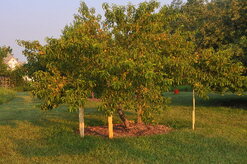 Heavy fruit loads this season may cause limbs to break if they are not given extra support. As fruits increase in size, the additional weight on individual branches may be substantial. One-inch thick boards that are 4 inches wide can be used to prop up limbs. You may wish to use two boards that overlap so the amount they overlap can be adjusted to change the total length of the board. Two to three screws can hold the two boards together. Cut a "V" on the top edge of the board on which the limb will rest so that it doesn't slip off. Long limbs that are heavily loaded with fruit may need a prop in the center and another to support the outer part of the limb. A plastic belt-like material that is about 2 inches wide may also be used. This can be tied to a heavily loaded limb, then to a large diameter limb above for support. Where a large limb is used for support, it is good to have it supporting limbs on opposite sides so the weight is balanced. Another solution is to wrap a tape or belt material around the tree in a spiral to prevent limbs from bending until they break. Heavy twine may be used, but it should be removed when the fruit is picked or soon after so it does not cut into the bark on the limb. Check trees regularly, up to two times a week during the last month the fruit are maturing. You will find additional limbs that need support. Tending to the heavily loaded tree limbs will reduce the number of broken limbs and help keep a balance of the fruiting wood in your tree. Next year, prune long, weak branches back to a side branch to help prevent this problem. (Ward Upham) Two common leaf-spot diseases will likely appear on tomato plants soon if they haven’t already. Septoria leaf spot and early blight are both characterized by brown spots on the leaves.
Septoria leaf spot usually appears earlier in the season than early blight and produces small dark spots. Spots made by early blight are much larger and often have a distorted “target” pattern of concentric circles. Heavily infected leaves eventually turn yellow and drop. Older leaves are more susceptible than younger ones, so these diseases often start at the bottom of the plant and work up. Mulching, caging, or staking keeps plants off the ground, making them less vulnerable. Better air circulation allows foliage to dry quicker than in plants allowed to sprawl. Mulching also helps prevent water from splashing and carrying disease spores to the plant. In situations where these diseases have been a problem in the past, rotation is a good strategy. It is too late for that now, but keep it in mind for next year. Actually, rotation is a good idea even if you have not had problems in the past. But many gardens are too small to make it practical. If you have room, rotate the location of the tomatoes each year to an area that has not had tomatoes or related crops (peppers, potatoes, eggplant) for several years. If rotation is not feasible, fungicides are often helpful. Be sure to cover both upper and lower leaf surfaces, and reapply fungicide if rainfall removes it. Plants usually become susceptible when the tomato fruit is about the size of a walnut. Chlorothalonil is a good choice for fruiting plants because it has a 0-day waiting period, meaning that fruit can be harvested once the spray is dry. Chlorothalonil can be found in numerous products including Fertilome Broad-Spectrum Landscape and Garden Fungicide, Ortho Garden Disease Control, GardenTech Daconil, Bonide Fungonil and others. Be sure to start protecting plants before these diseases are first seen if they have been a problem in the past. It is virtually impossible to control these diseases on heavily infected plants. If chlorothalonil doesn’t seem to be effective, try mancozeb (Bonide Mancozeb Flowable). Note that there is a five-day waiting period between application and when the fruit can be harvested. You may wish to pick some tomatoes before they are fully red just before you spray if you use Mancozeb as the tomato fruit will ripen inside. (Ward Upham) 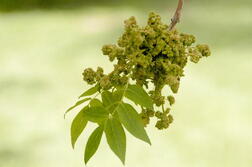 You may have noticed ugly, gall-like masses in ash trees. This is most likely the ash flower gall. As with most galls, the ash flower gall is unsightly but does not harm the health of the tree. Though most galls are caused by insects, this one is caused by an eriophyid mite, Eriophyes fraxinivorus. These tiny mites (about 0.5 mm long) feed on the male flower clusters of ash early in the season, transforming the male flowers into irregular, fringed masses. These masses persist until the following spring and become more noticeable when the leaves drop in the fall. Masses start out green but turn black as they dry. As mentioned, the ash flower gall is unsightly but does not harm the health of the tree. The mites are also difficult to control because they are able enter the flower bud before it is visibly open. Control measures are not recommended. (Ward Upham) 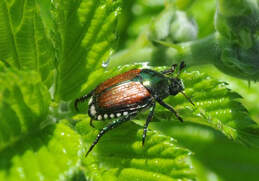 Japanese beetles feed on over 300 species of plants including rose, birch, linden, crabapple, grape, Virginia creeper, and buckeye. Adults are approximately 7/16-inch long and metallic green with coppery wing covers. They sport a series of white dots made up of tufts of hair that project from under the edges of the wing covers on the back half of the insect. This characteristic is used to distinguish Japanese beetles from other similar beetles. Japanese beetles feed on leaves, flowers and wounded or mushy fruit. Adults often feed on the green material on the upper surface of the leaf leaving a lacelike or “cellophane” appearance. Most feeding activity occurs over a 4 to 6 week period though individual beetles usually live about 30 to 45 days. Japanese beetles tend to be gregarious and feed in groups, starting at the top of a plant and working down. Warm, sunny weather is preferred with beetles favoring plants in full sun. When disturbed, adults fold their legs and drop from foliage. Adult beetles can be killed by shaking the beetles from the plant into a jar or bucket containing soapy water. This is best done in the morning when the insects are sluggish. Numerous insecticides can be used including pyrethroid products such as cyfluthrin (Tempo, Bayer Vegetable & Garden Insect Spray), bifenthrin (Hi-Yield Bug Blaster II) and cyhalothrin (Bonide Beetle Killer, Spectracide Bug Stop Indoor + Outdoor Insect Killer, Spectracide Triazicide, Bonide Caterpillar Killer). Carbaryl (Sevin) can also be used. The pyrethroid products normally give 2 to 3 weeks protection with carbaryl not lasting as long; usually 1 to 2 weeks. All of the above insecticides are detrimental to natural controls such a parasitoids and predators or other pests including the two-spotted spider mite. Neem products (Natural Guard Neem-Py, Fertilome Triple Action Plus) and Pyola (pyrethrins in canola oil) will provide deterrence for 3 to 4 days. Japanese beetle traps used by homeowners tend to attract more beetles than they kill though some mass trapping of beetles has shown some promise on a commercial scale. See https://ipm.missouri.edu/MEG/2018/1/mass_trapping_japanese_beetles/. (Ward Upham) 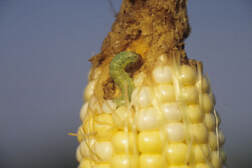 Corn earworm tends to be a problem every year on sweet corn in Kansas. The earworm moth lays eggs on developing silks at night. When the egg hatches, the larva crawls down the silk and into the ear. Feeding starts at the tip of the ear and works down. Though several earworms may hatch and attack a single ear, only one is usually present at harvest due to the cannibalistic nature of the insect. Control is challenging as silks continue to grow over a period of time. This means that even if silks are treated, new silk will appear that hasn't been protected. Applications every 2 to 3 days are needed for insecticides to be effective, especially in early July when peak flight of these moths usually appear. There is a three-week period from silking to harvest, but there is only a two-week period from when the silks appear to when they begin to dry. Since moths prefer juicy silks and shun those that have started to dry, insecticides are only needed the first two weeks of silking. Homeowners can use cyfluthrin (Baythroid; BioAdvanced Vegetable and Garden Insect Killer) or spinosad (Natural Guard Spinosad, Captain Jack's Deadbug Brew, Bonide Colorado Potato Beetle Beater and Monterey Garden Insect Spray). Spinosad is an organic product. Commercial growers have additional choices including zeta-cypermethrin (Mustang Max), bifenthrin+zeta-cypermethrin (Hero), spinetoram (Radiant) and flubendiamide (Belt). Though more time consuming, mineral or other light horticultural oils may also be used as an organic control. The oil is placed inside the silk end of the ear with a medicine dropper (½ to 3/4 of a dropper) when the tips of the silks begin to wilt and turn brown. This will coat the earworms already present and likely suffocate. Applying the oil before the silk has begun to brown may interfere with pollination, leading to incompletely filled ears. (Ward Upham) 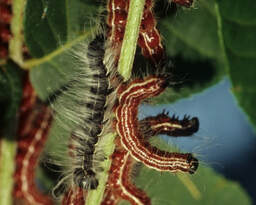 If you notice leaves disappearing from walnut trees, it may be walnut caterpillars. Walnut caterpillars attack primarily black walnut, pecan, and several species of hickory trees, but may also attack birch, oak, willow, honey locust, and apple trees. Walnut caterpillars overwinter as pupae underground beneath host trees. In late spring, moths emerge and deposit egg clusters on lower leaves. By the end of June, newly emerged and gregarious larvae skeletonize leaves. Larger hairy, brick-red larvae consume greater amounts of leaf tissue, and nearly matured gray larvae devour entire leaves, including petioles. As mentioned earlier, walnut caterpillars are gregarious. In other words, they feed in groups. A single tree may contain several groups. When disturbed, larvae arch their bodies in what looks like a defensive move. Larvae crowd together on the lower parts of trees to molt and leave an ugly patch of hairy skins. Mature larvae, 2 inches long, descend or drop to the ground where they enter the soil to pupate. A second generation occurs soon, creating the overwintering pupae. Removing leaves with egg masses is an effective way to control walnut caterpillars. This may be impractical with large trees or when too many infested leaves are present. Bands of Tree Tanglefoot pest barrier may be used to snare larvae as they migrate to main branches or the trunk to molt. Insecticides such as spinosad (Natural Guard Spinosad, Captain Jack's Deadbug Brew, Bonide Colorado Potato Beetle Beater and Monterey Garden Insect Spray) permethrin (numerous trade names) malathion or cyfluthrin (Tempo, BioAdvanced Vegetable and Garden Insect Spray) may provide the most practical means of control. The spinosad products are organic controls. (Ward Upham) 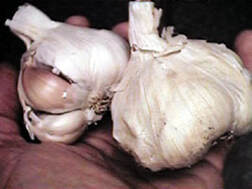 While related to onions, garlic needs to be harvested much differently. Garlic is best harvested when it still has five to six green leaves left. Garlic is sensitive to heat and excess sunlight so leaving garlic in the ground until all the leaves have died down allows potentially hot weather to start "cooking" the bulbs. The more leaves that die the more likely you are to have some of the outer bulb wrappers split which lets dirt, moisture and disease organisms in to the bulb. Garlic has an aggressive root system that makes pulling them difficult if not impossible. Use a shovel or preferably a potato/digging fork to lift the bulbs out of the ground. Carefully knock the loose dirt off the roots. Don t leave in the bulbs in direct sunlight for very long (more than fifteen minutes.) Tie up to ten plants together with twine and hang in a dry and warm location to dry out. Tying more than about ten plants together can result in longer drying periods and more chance for storage molds to start developing. You want the tops to finish drying down so there is no moisture left in the neck when you cut it. Depending on the year and location this may take two to six weeks. Once the necks are dry, trim the tops back to about one inch. "Hard-necked" cultivars will require pruning clippers to do this, "soft-necked" cultivars can be trimmed with heavy scissors. Brush the remaining dirt out of the roots and trim them back to about a quarter of an inch. If outer bulb wrappers are dirty carefully remove them but don’t remove any more than necessary. Bulb wrappers help protect the cloves. Carefully check each bulb for soundness by gently squeezing the bulb to check firmness. If any bulbs seem excessively soft, set them apart to be used first. Like onions they are best stored in mesh bags and should never be stored in sealed plastic bags. Paper sacks can be used but pack them lightly. Ideal storage conditions are 32 to 35 degrees and 65 to 70% humidity. For most gardeners you are better to just leave them at cool room temperature. Refrigerator storage conditions very closely replicate fall soil conditions when planting and will stimulate cloves to start bud swelling and germinating. Not all garlic types have the same storage life. Some will only store for 4 to 6 months, while others can store for 10 to 12 months. (Chuck Otte) |
AuthorsCynthia Domenghini runs the Horticulture Response Center in the Department of Horticulture and Natural Resources at Kansas State University. Other contributors include K-State Extension Specialists. Archives
March 2024
Categories
All
|
| K-State Research and Extension Horticulture Newsletter |
|
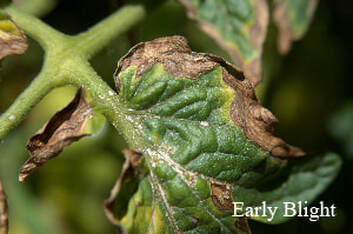
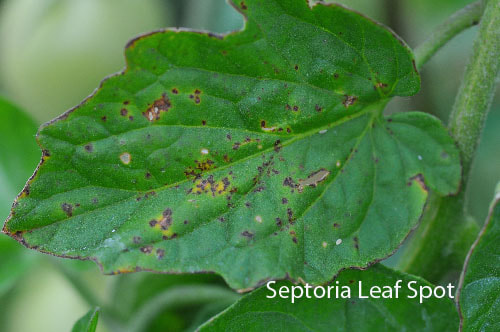
 RSS Feed
RSS Feed
